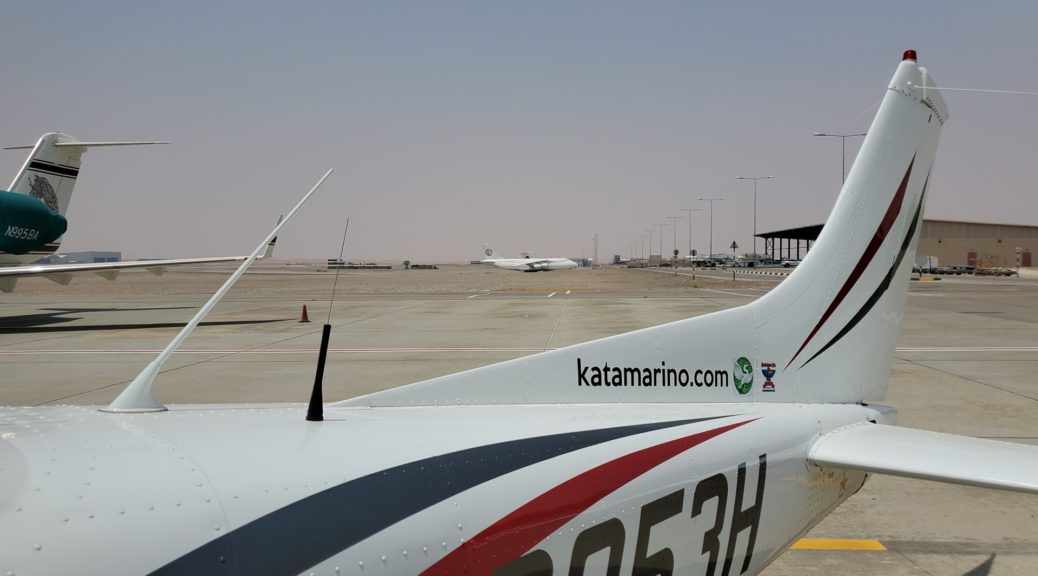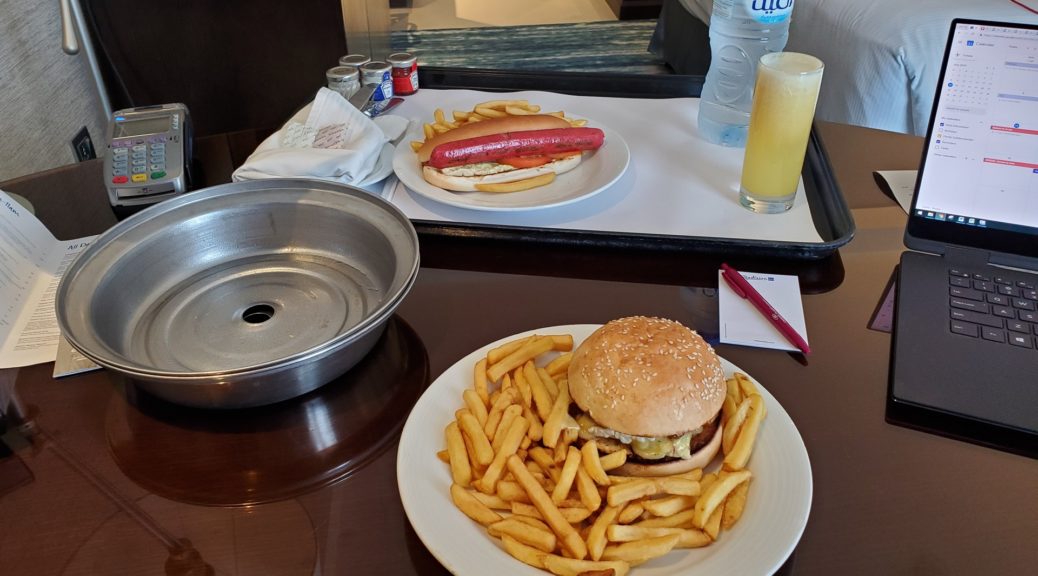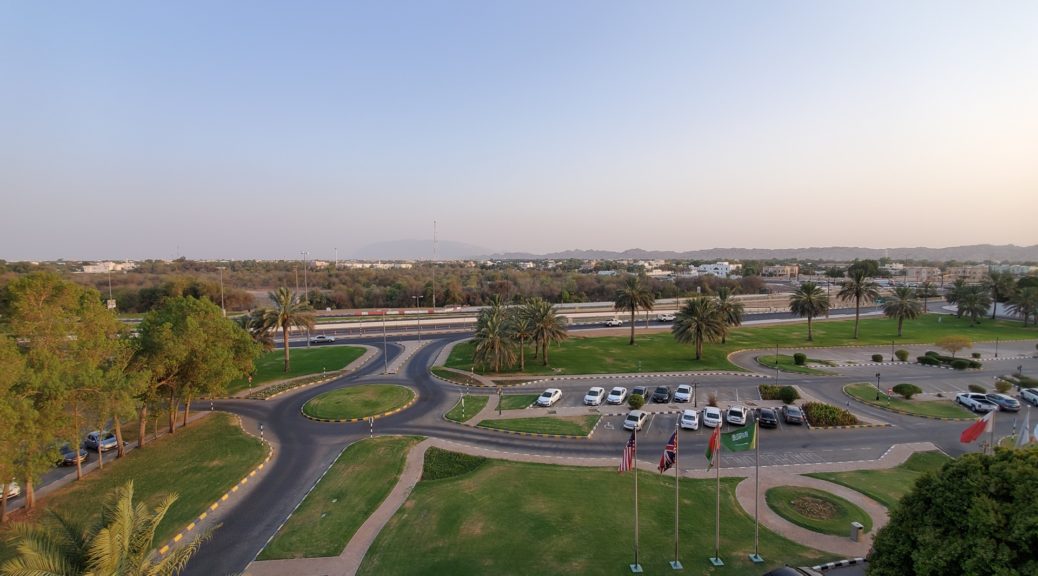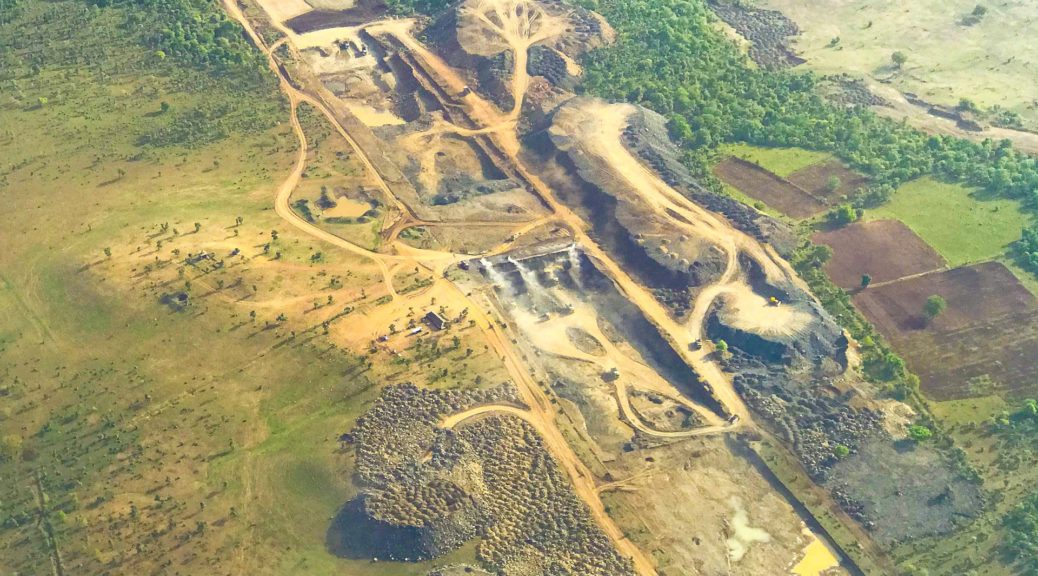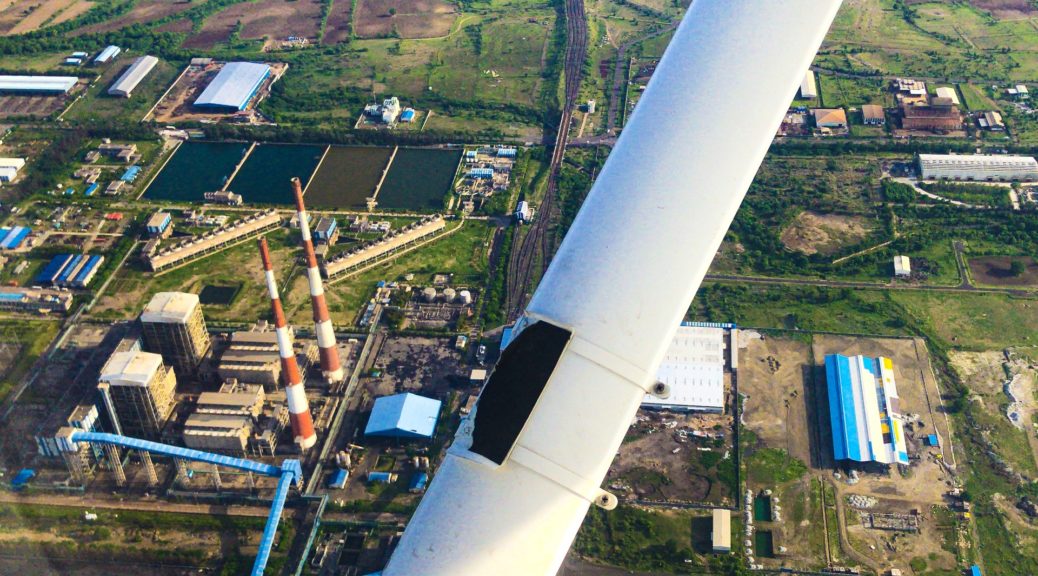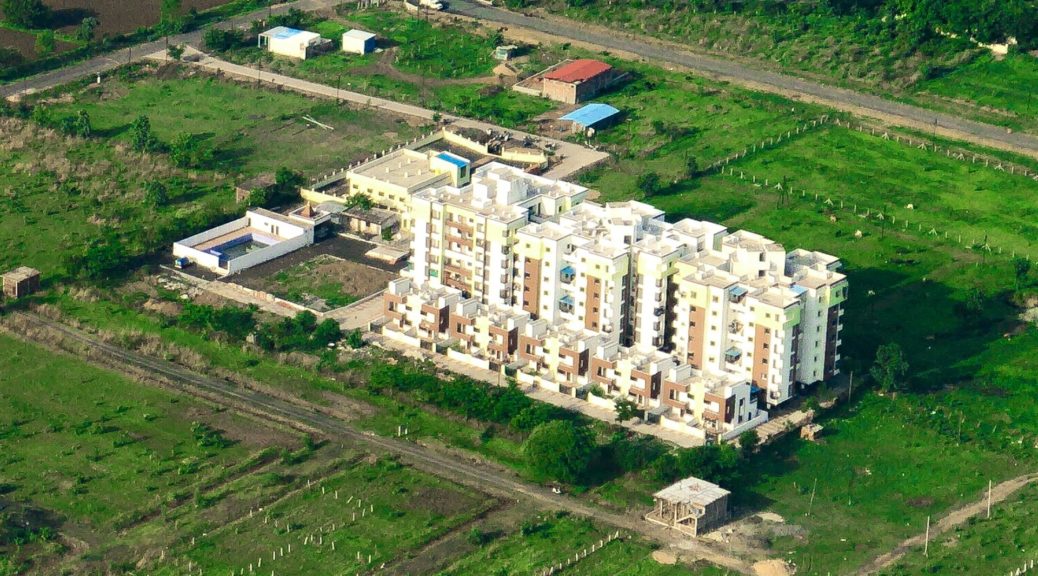Round the World – Eurasia Days 17 and 18
Compared to our previous two long-haul adventures the day’s flight was short and easy; a quick run down the gulf to the United Arab Emirates. I had selected the Emirate of Al Ain as it offered the closest airport to the Indian mainland, which would be our subsequent destination. We took a taxi back to the airport and after a short wait the handling agent met us and led us through security. After the experience in Egypt we made sure to warn him in advance that we had liquids, and had him brief the security staff, making the process very smooth. Everybody at the airport was friendly and pro-actively helpful, a far cry from anything we get in the UK!
We had another car ride around the airport perimeter, back to the MENA hangar. As well as commercial flights, the Bahrain airport hosts a DHL hub and a US air force contingent. It was interesting to see the military helicopters and other aircraft being worked on as we drove right past their maintenance hangars. GASE had filed our flight plan for us already, picking up and correcting my rather naive routing error; I’d forgotten that most countries here need overflight permits, and had routed us over Qatar. A short deviation corrected that issue. No fuel was needed here, as we had plenty left over despite our 950nm flight the previous day, so we pre-flighted and set off east before turning south down the center of the Gulf. As we departed from Bahrain, we could clearly see the huge amount of land reclamation that was going on, with tonnes of sand being dumped along the coasts to expand the country. What were previously beach-front villas were now well inland. I would not have been happy if I’d bought one for the sea views!
We were out of sight of land for the majority of the flight, but that didn’t mean we were devoid of sightseeing. An array of linked oil platforms stretched down the Gulf, with tankers and support vessels shuttling to and fro. We even flew over what was clearly a very small artificial island; we couldn’t begin to guess at its purpose. ATC took us off of our route onto radar vectors, and brought us ashore a little east of Abu Dhabi over large shipping facilities that were being expanded still further. Everything was done on a very procedural basis here and we were directed to fly the DME arc to the ILS approach for landing in Al Ain, a much longer endeavour than a simple visual approach. ATC passed the time asking us about where we’d flown from; the controller was American and surprised to see an N-reg Cessna 182 so far from home!
The apron in Al Ain was mostly empty. We parked up next to a couple of private jets with cockpit covers on that looked like they hadn’t moved in a while. Given the heat, we decided to fuel on departure, and covered the aircraft up in anticipation of a few nights stay. The last-minute change of plans for the next leg into India meant that we were expecting a couple of days delay, waiting for the permit. A very reasonably priced taxi took us to the Radisson Blu where we tucked in to some room service, before receiving notification from GASE; they’d managed to get the India permit in place for plan B quicker than expected. The routing might be changed, but at least the schedule was secure. The bad news was that our expected day or so of rest had turned in to a 2am wake-up, for a very early take-off to Nagpur the next day! With the help of GASE I took care of the flight plan, and went to bed.
When the alarm went off, it felt like I had barely slept. Outside was still pitch black. I rolled out of bed, dressed, and met Gavin in the lobby before taking a taxi to the airport. We waited for a short time in departures for the handlers to turn up, and Gavin took full advantage of this time to noisily empty the vending machine (to the chagrin of a nearby policeman who was trying to sleep). The hotel had been unable to offer a single snack, despite having a menu of them (“Oh, we don’t do those any more”), and we did not want to take off on an 11-hour flight with no breakfast, and nothing to eat.
The handlers that GASE had arranged were efficient, and we were soon back at the aircraft and fueling up. For this long a flight we took on 3 50-gallon (200 liter) barrels of fuel, in addition to the 25 gallons (100 liters) or so that we still had on board; this left us with 175 gallons (660 liters). The stock aircraft only holds 88 gallons (330 liters), so this gives an indication of quite how much extra fuel capacity we have available; we weren’t even close to being full! Although coming from drums, the fuelers had a quick and easy electric pump setup, so things were much less painful than the fiasco with the Egyptian military. It was still pitch dark, and relatively cool, as we rolled down the runway and lumbered into the air on the standard instrument departure.
Before long it became obvious to both us and the controller that we wouldn’t be reaching the required altitude to cross into Oman any time soon. She vectored us off of the departure route and sent us out to the west, allowing more time and distance for us to claw our way up to 7,500ft. This was high enough to be accepted by Oman, whose ATC we had been warned was generally inflexible. I was a little concerned about being able to climb high enough to keep following our assigned airway, which ran straight over 9,000ft mountains; but as soon as we broached the subject, we were cleared directly out over the sea towards India, with no questions asked. Thanks, Oman! As it turns out, we’d later be charged $180 for the short time we spent in their airspace. At that price, I certainly expect good service.
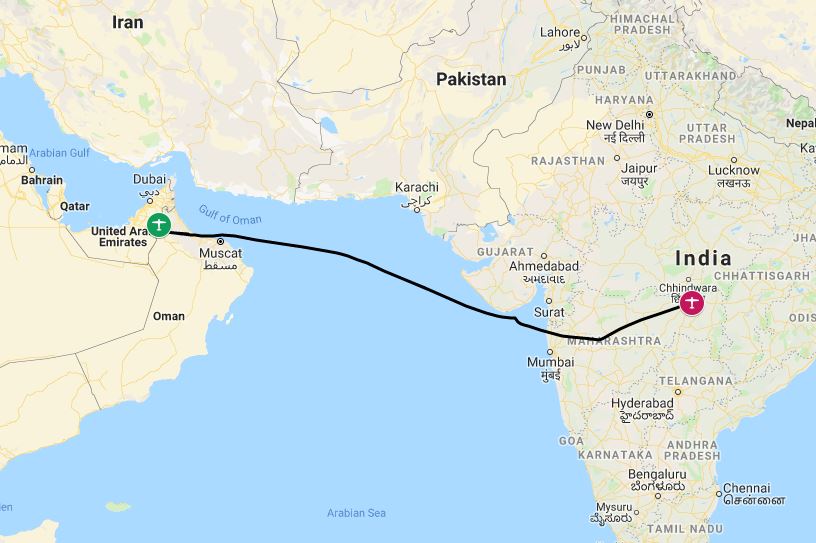
So began the long sea crossing to India. The coast of Oman slipped away from us in the dawn light. We relayed position reports via passing airliners as we were well out of radio range of the ground stations at our altitude. At our altitude we were comfortably above the low level cloud, with blue skies above, and smooth air. Once we finally managed to get in direct contact with Indian ATC, via relays from airlines such as Etihad, they started redirecting us south of our planned route. They didn’t tell us why, and for some reason they would only ever give us the next way point they wanted us to fly to. This meant that as we drew within a few minutes of each way point, I had to call up ATC and ask them where we should be flying to after we reached it. They never seemed to cotton on to the fact that an airplane may need to know where to head next.
The reroute kept us over the sea for much longer than originally planned. Apparently ATC didn’t appreciate that we only had a single piston engine, and therefore would prefer not to be over the water any longer than needed. We eventually coasted in and were allowed to turn back north towards Nagpur; now that we were over land, towering cumulous cloud started to build and we climbed slowly higher to remain above it, ending up at 13,000ft. A little east of Mumbai ATC dropped us entirely and told us to call Nagpur when we got close, a couple of hours from now. Fine by us; that meant we could deviate left and right, and climb and descend, to our heart’s content.
About 100 miles from Nagpur we managed to contact them, and we cleared in to fly a DME arc to the ILS approach. The weather was fine, so the instrument approach was a bit moot. We started a slow descent and, 15 miles or so out, turned on to the DME arc. I knew there was a good reason to have kept my DME installed! In all honesty, the autopilot just flew the leg for us using a GPS overlay, but it was nice to have the DME on and monitoring, and feel like we were being legitimate. Amusingly, all the while Nagpur ATC had been referring to us as a “Citation” 182 (the Citation series is Cessna’s private jet line). He must have been wondering why we were flying so slowly!
A military helicopter was flying circuits as we landed; it looked like an old Soviet type. We taxied in, and were met by a marshaller who parked us on the apron across from the main terminal. Moments later our handling agent arrived on a rickety tractor, and dove straight in to the paperwork. He was friendly and competent, and quickly ran through what we’d need to do for fuel and airport fees.
A complication presented itself in that apparently these parties would only accept payment in pristine US dollars, newer than 2013. I had plenty of dollars but hadn’t been aware of these strict requirements; I’m not sure how they expected people to source such dollars when presented with the demand on arrival. It was apparently a fairly new, and very local, thing as previous flights that GASE had sent through here hadn’t had the issue. Perhaps we just looked dodgy! Eventually we managed to cobble together enough from what I had on hand.
Immigration was slow, although still much quicker than expected, and before long we were in a taxi on our way to the Radisson Blu airport hotel. Things on the street were just how I’d imagined; chaotic traffic, cows wandering around, but somehow it all still worked! After our 11 hour flight, we decided on dinner in the hotel restaurant; naturally, it had to be a curry!
Click here to read the next part of the story.



















